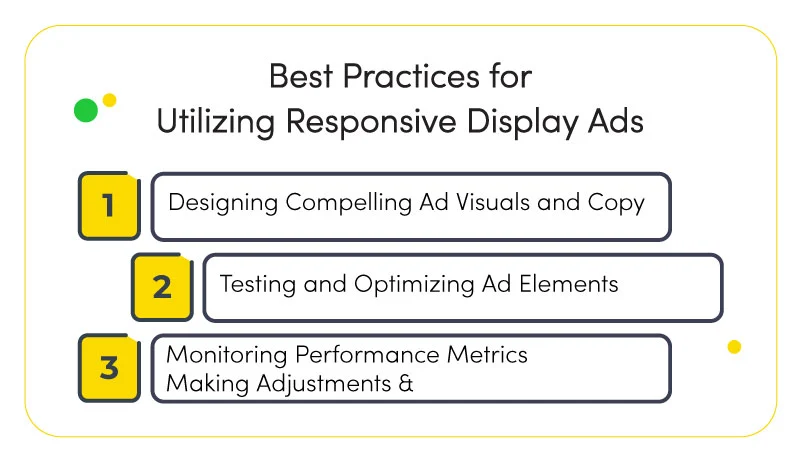In the rapidly evolving world of digital advertising, staying ahead of the competition requires innovative strategies that not only capture attention but also deliver tangible results. This is where the benefits of using responsive display ads come into play. Designed to adapt seamlessly across different devices and placements, responsive display ads offer a range of advantages that empower businesses to maximize their reach, engage their target audience, and optimize their ad performance.

In this article, we will explore the numerous benefits of using responsive display ads and uncover how they can revolutionize your advertising strategy, enabling you to achieve unprecedented success in the digital realm. So, let’s dive in and discover the immense potential that responsive display ads hold for your business.
Benefits of Responsive Display Ads
Responsive display ads excel in driving improved ad performance and effectiveness. Let’s explore some of their most important benefit:
- Increased Reach and Visibility: In the vast digital landscape, grabbing the attention of potential customers is no easy feat. However, responsive display ads provide an exceptional solution by offering increased reach and visibility. By automatically adjusting their format and size to fit various placements and devices, these ads can seamlessly adapt to different screens, whether it’s a smartphone, tablet, or desktop computer. This adaptability ensures that your ads are displayed optimally across a wide range of platforms, expanding your reach and increasing the likelihood of capturing the attention of your target audience.
- Improved Ad Performance and Effectiveness: Through their dynamic nature, these ads enable automatic optimization based on real-time data, allowing them to learn which combinations of assets and messages resonate best with your audience. By leveraging machine learning algorithms, responsive display ads continuously analyze and refine their performance, ensuring that your ads are displayed at the right time to the right audience. This optimization process maximizes the impact of your advertising efforts and boosts overall ad effectiveness.
- Enhanced User Experience: User experience plays a pivotal role in capturing and retaining the attention of potential customers. With responsive display ads, you can deliver an enhanced user experience that seamlessly integrates with the content and design of websites and apps. By adapting to the specific format and layout of each platform, these ads blend naturally with the user’s browsing experience, leading to a more cohesive and non-intrusive advertising approach. This harmonious integration enhances user engagement, fostering a positive perception of your brand and increasing the likelihood of conversions.

- Time and Resource Efficiency: Managing multiple ad versions for different devices and placements can be a time-consuming and resource-intensive task. However, responsive display ads alleviate this burden by streamlining the ad creation process. With a single ad that automatically adjusts to various formats and placements, you can save valuable time and resources that would otherwise be spent on designing, testing, and managing multiple ad variations. This efficiency allows you to focus on other critical aspects of your advertising strategy, such as crafting compelling copy and refining your targeting approach.
- Adaptability to Different Devices and Placements: The digital landscape is incredibly diverse, with users accessing content across a wide range of devices and platforms. Responsive display ads shine in their ability to adapt seamlessly to these various environments. Whether your target audience is browsing a news website, using a mobile app, or scrolling through social media feeds, responsive display ads can adjust their size, format, and appearance to ensure optimal presentation. This adaptability not only enhances the visual appeal of your ads but also ensures that they are displayed in a manner that resonates with users on their preferred devices and platforms.
By harnessing the increased reach and visibility, improved ad performance and effectiveness, enhanced user experience, time and resource efficiency, and adaptability to different devices and placements that responsive display ads offer, businesses can elevate their advertising efforts to new heights, reaching their target audience effectively and achieving remarkable results in the digital advertising realm.
The Role of Responsive Display Ads in Advertising Strategy
When it comes to crafting a comprehensive and impactful advertising strategy, businesses must explore innovative approaches that can effectively engage their target audience and deliver measurable results. In this dynamic digital landscape, the role of responsive display ads emerges as a game-changer. These adaptable and versatile ads have the power to seamlessly integrate with your overall advertising strategy, elevating your campaigns to new heights of success.
- Versatility and Suitability for Various Campaign Objectives: In today’s dynamic digital landscape, having a versatile advertising strategy is crucial to effectively reach and engage your target audience. Responsive display ads play a pivotal role in achieving this versatility. Whether your campaign objectives revolve around brand awareness, driving website traffic, or promoting specific products or services, these ads can be tailored to suit your goals. Their adaptability allows you to deliver compelling messages and visuals that align with your specific campaign objectives, ensuring that your advertising efforts resonate with your audience and drive desired actions.
- Integration with Other Google Ads Features and Tools: Google Ads provides a plethora of powerful features and tools that enable advertisers to refine and optimize their campaigns. Responsive display ads seamlessly integrate with these tools, enhancing your advertising strategy’s effectiveness. By leveraging Google’s machine learning capabilities, responsive display ads can be optimized in real time, dynamically adjusting their components to deliver the best possible results. Furthermore, they can be combined with audience targeting options, remarketing campaigns, and contextual targeting to refine your audience reach and further personalize your ad delivery.

- Effective Targeting and Audience Reach: Reaching the right audience with your advertising message is paramount to achieving success. Responsive display ads offer effective targeting options that empower you to connect with your desired audience segments. Through demographic targeting, you can tailor your ads to specific age groups, genders, and locations. Additionally, you can leverage audience targeting based on interests, behavior, or remarketing lists to ensure that your ads reach users who are most likely to be interested in your offerings. This precision targeting helps you make the most of your advertising budget by focusing on the audience segments that are most relevant to your business.
By incorporating responsive display ads into your advertising strategy, you unlock a world of possibilities. Their versatility and suitability for various campaign objectives allow you to adapt your messaging to achieve specific goals. Integration with Google Ads features and tools enhances your campaign’s performance and optimization capabilities. Moreover, the effective targeting and audience reach offered by responsive display ads ensures that your message is delivered to the right people at the right time, increasing the chances of conversion and overall campaign success. Harness the power of responsive display ads to elevate your advertising strategy and maximize your return on investment.
Best Practices for Utilizing Responsive Display Ads
To truly harness the power of Google responsive display ads and maximize their impact on your advertising campaigns, it is essential to follow industry best practices. By incorporating these proven strategies into your approach, you can ensure that your responsive display ads captivate your audience, drive engagement, and deliver exceptional results. In this section, we will explore the key best practices for designing compelling ad visuals and copy, testing and optimizing ad elements, and monitoring performance metrics to make data-driven adjustments. Let’s dive in and discover how to unlock the full potential of your responsive display ads for unparalleled advertising success.
- Designing Compelling Ad Visuals and Copy: When it comes to capturing the attention of your target audience, visually appealing and compelling ad creative is essential. Best practices for Google responsive display ads dictate that you invest time and effort into designing high-quality visuals and crafting persuasive ad copy. Ensure that your visuals are eye-catching, relevant to your brand, and optimized for various screen sizes. Experiment with different color schemes, imagery, and fonts to create a visually appealing and cohesive ad experience. Additionally, focus on crafting concise and impactful ad copy that clearly communicates your message and entices users to take action. Remember, a captivating visual paired with persuasive copy can significantly enhance the effectiveness of your responsive display ads.

- Testing and Optimizing Ad Elements: Continuous testing and optimization are vital components of any successful advertising campaign. The importance of A/B testing different ad elements to identify what resonates best with your target audience can not be overstated. Experiment with variations of headlines, descriptions, visuals, and calls to action to determine which combinations yield the highest engagement and conversions. Analyze performance metrics such as click-through rates, conversion rates, and bounce rates to gain insights into the effectiveness of different ad elements. By iterating and optimizing based on these insights, you can continually improve the performance and impact of your responsive display ads.
- Monitoring Performance Metrics and Making Adjustments: To ensure that your responsive display ads are delivering the desired results, it is crucial to regularly monitor and analyze performance metrics. Keep a close eye on key metrics such as impressions, clicks, conversions, and cost-per-conversion. Leverage the reporting and analytics tools provided by Google Ads to gain in-depth insights into the performance of your ads. Identify trends, patterns, and areas of improvement, and make data-driven adjustments accordingly. Whether it’s tweaking ad placements, refining audience targeting, or adjusting bidding strategies, being proactive in monitoring and optimizing your responsive display ads can significantly enhance their effectiveness and drive better campaign outcomes.
The Best practices for Google responsive display ads revolve around the core principles of captivating design, strategic testing, and continuous optimization. By following these practices, you can unlock the full potential of responsive display ads and harness their versatility to drive exceptional results for your advertising campaigns. Remember, in the ever-evolving digital landscape, staying ahead requires a commitment to ongoing refinement and improvement. Embrace these best practices to ensure that your responsive display ads are finely tuned to engage your audience, inspire action, and achieve your campaign objectives with utmost efficiency.
Conclusion
The benefits of using responsive display ads cannot be overstated. With their ability to adapt seamlessly to various devices and placements, these dynamic ads offer increased reach, improved ad performance, enhanced user experience, time and resource efficiency, and adaptability. By incorporating responsive display ads into your advertising strategy, you can effectively engage your target audience, drive conversions, and achieve remarkable results. Furthermore, by following best practices for Google responsive display ads, such as designing compelling ad visuals and copy, testing and optimizing ad elements, and monitoring performance metrics, you can unlock the full potential of these ads and ensure their effectiveness in achieving your campaign objectives. Embrace the power of responsive display ads and seize the opportunities they offer to elevate your digital advertising efforts to new heights of success.
FAQs
What is an advantage of responsive display ads?
One advantage of responsive display ads is their adaptability to different devices and placements, ensuring optimal presentation and visibility across various platforms, increasing reach and engagement with your target audience.
How can responsive display ads benefit my advertising campaign?
Responsive display ads can benefit your advertising campaign by improving ad performance and effectiveness, enhancing user experience, saving time and resources through automated resizing and formatting, and offering a cost-effective advertising solution that dynamically optimizes ad creation and relevancy.
Why should I choose responsive display ads for my advertising strategy?
Choosing responsive display ads for your advertising strategy allows you to tap into their versatility, adaptability, and seamless integration with other Google Ads features and tools, enabling you to achieve various campaign objectives, effectively target your audience, and maximize your advertising reach and impact.







 Facebook Ads Spy Tool
Facebook Ads Spy Tool TikTok Ads Spy Tool
TikTok Ads Spy Tool